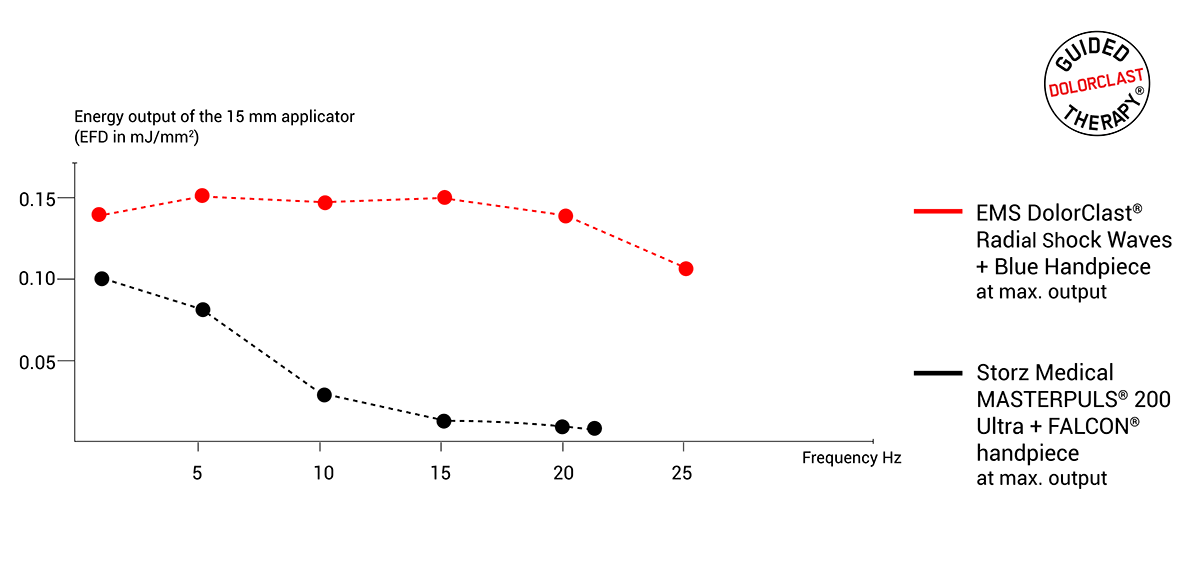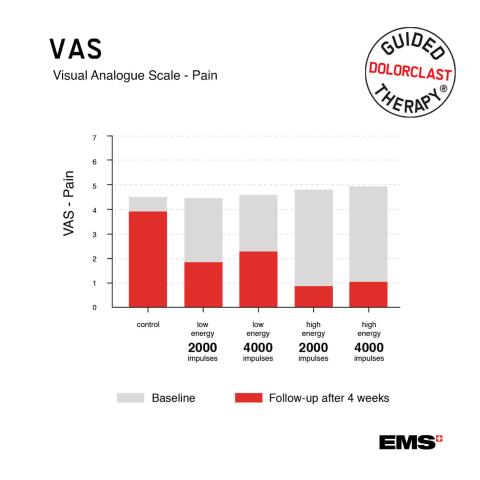

Superior Performance of EMS DolorClast Radial Shock Waves

Radial extracorporeal shock wave therapy (rESWT) is a safe and effective treatment modality for a variety of musculoskeletal conditions. Its effectiveness depends on energy output at evidence-based, clinically relevant device settings. Therefore, researchers started in 2015 to investigate how different rESWT devices differ regarding their energy output.
These differences were further investigated in a recent comparative study by Nina Reinhardt and colleagues at the Helmholtz Institute for Biomedical Engineering, RWTH Aachen (Aachen, Germany). The authors of this study compared the latest EMS DolorClast® Radial Shock Waves and the Storz MASTERPULS® 200 ultra. They found substantial differences regarding the total energy that can be delivered to a patient.
"Radial shock wave devices vary significantly in their energy output"
Why is this important to practitioners? Because the latest basic science and clinical research have confirmed the importance of higher energy delivery for better treatment results. Yet, not all devices are capable of delivering high energy.
Read more about these thought-provoking insights below.
New study comparing the EMS DolorClast Radial Shock Waves and the Storz MASTERPULS 200 ultra devices
Influence of the pulse repetition rate on the acoustic output of ballistic pressure wave devices
Nina Reinhardt*, Jens Wegenaer & Matías de la Fuente Link to full study
In this bench test study, two rESWT devices and their energy output at different settings were investigated in a high-precision, experimental test setup:
- EMS DolorClast® Radial Shock Waves with BLUE handpiece and 15-mm applicator
- Storz MASTERPULS® 200 ultra with FALCON handpiece and 15mm applicator
- Both devices were used up to their highest possible energy output settings.
The results of this study showed that by increasing the frequency setting (pulse repetition rate, PRR) the energy delivery varied between the two devices:
The maximum energy delivery dropped sharply, up to 90.9%, for the Storz Medical MASTERPULS® 200 ultra.
However, it only decreased slightly, 18.8%, for the EMS DolorClast® Radial Shock Waves device.
DolorClast Radial Shock Waves delivers high energy at all frequencies

The maximum energy delivery dropped sharply, up to 90.9%, for the Storz Medical MASTERPULS® 200 ultra.
However, it only decreased slightly, 18.8
The EMS DolorClast®️ Radial Shock Waves device succeeded in delivering clinically relevant energy outputs at all frequency levels. This is important for clinical practice, because clinical outcomes require sufficient energy delivered to the tissue. Reinhardt et al. (2022) concluded that manufacturer-reported energy levels at 1 Hz cannot guarantee outcomes at higher frequencies. The study demonstrated that the EMS DolorClast®️ Radial Shock Waves device guarantees a high energy output at all frequency settings.
Where do the differences in energy delivery come from?
For more than 20 years, EMS DolorClast® Radial Shock Wave has followed clinical evidence: To achieve the best therapy results, high-energy shock wave therapy has proven the most efficient. The high energy delivery of the EMS DolorClast® Radial Shock Waves device is enabled by the combination of highly effective air management of the compressors and the unique design of the EVO BLUE and BLUE handpieces.

EMS pushed physics to the limit to achieve maximum energy output at all frequencies to successfully treat indications for orthopedics and sports medicine:
Unique 2-compressor technology delivers constant air pressure to the DolorClast® BLUE handpiece
Optimized air management in the hand piece for maximum projectile speed
The results are optimized radial extracorporeal shock waves to deliver stable, reproducible high energy to the treatment area. DolorClast® Radial Shock Waves delivers up to ten times more energy than the Storz MASTERPULS® 200 ultra.
How relevant are high energy output and frequency for clinical practice?
High-energy radial shock wave therapy delivers superior therapy outcomes compared to low-energy radial shock wave therapy.
This has been confirmed again by a recent study from 2021, in which high and low energy radial shock wave therapy and their effect on pain relief (VAS) for patients with knee osteoarthritis were investigated. In this study, the DolorClast® EVO Blue handpiece was used with a 10mm applicator at a shock frequency of 8Hz.
This study demonstrated that high-energy therapy (0.24 mJ/mm2) resulted in better therapy outcome than low-energy therapy (0.12 mJ/mm2).
In addition, low-energy could not be compensated by increasing the number of shocks, as the latter did not result in better treatment outcome.
Therefore, practitioners should choose a rESWT device that provides high energy output.

Radial shock wave therapy can reduce lay-off times in elite sports and reduce re-injury rates.
A collaboration between researchers from the Ludwig-Maximilians University of Munich (Munich, Germany) and the medical staff from an elite football team competing in the first/second Bundesliga retrospectively assessed the treatment and recovery times of 31 professional football players, all of whom had muscle injuries.
The key findings of this study were the following:
Incorporating rESWT/fESWT into a multimodal therapy approach is safe, effective and beneficial for the athletes suffering from various muscle injuries.
Average lay-off times after type 1a (muscular tightness/hypertonicity) and 2b (muscular strain injury) muscle injuries were 50% shorter than comparable cases reported in literature.
Treatments during this study were performed in the majority of cases at 20Hz. The positive outcomes were linked to the high energy delivery provided by the EMS DolorClast®️ devices used at high frequencies.

Summary
In short, by using an EMS DolorClast®️ radial shock wave device, you will benefit from:
- High energy at all treatment frequencies
- Clinically-proven treatment outcomes
- Shorter treatments for improved patient experiences
- Greater success in your practice
- This is the aim of Guided DolorClast® Therapy.
The bench test comparative study conducted by Reinhardt et al. (2022) demonstrated that the DolorClast® Radial Shock Waves device delivered higher energy than the Storz MASTERPULS® 200 ultra - especially at the high-frequency settings applied in practice.
"The effects achieved by the EMS DolorClast Radial Shock Waves device may not be ahieved with the devices with significantly lower energy output."
We prove: EMS DolorClast devices lead in the field of clinical evidence and therapy results
More than 50% of all published level 1 clinical trials with a radial shock wave device are done with an EMS DolorClast® device.
In 80% of these studies, treatments with EMS DolorClast® radial shock wave devices demonstrated better clinical outcomes than control groups.
More than 60% of all studies that proved the cellular and biological effects of radial shock waves are done with EMS DolorClast® devices.
"These study results may not apply to other radial shock wave devices, which do not deliver the same energy output"
1) Schmitz C, Császár NB, Milz S, Schieker M, Maffulli N, Rompe JD, Furia JP. Efficacy and safety of extracorporeal shock wave therapy for orthopedic conditions: a systematic review on studies listed in the PEDro database. Br Med Bull 2015;116(1):115-38.
2) Császár NB, Angstman NB, Milz S, Sprecher CM, Kobel P, Farhat M, Furia JP, Schmitz C. Radial shock wave devices generate cavitation. PLoS One 2015;10(10):e0140541.
3) Reinhardt N, Wegenaer J, de la Fuente M. Influence of the pulse repetition rate on the acoustic output of ballistic pressure wave devices. Sci Rep 2022;12(1):18060.
4)Measured by the positive pulse intensity integral (which is equivalent to the energy flux density; EFD)
5) The EVO Blue and the latest generation BLUE handpiece both use the same technology and therefore deliver almost identical energy outputs. On the other hand, the compressor technology and the power input measured in bar is of minor importance, as the energy management and transformation in the handpiece is the decisive criteria for energy output.
6) Zhang YF, Liu Y, Chou SW, Weng H. Dose-related effects of radial extracorporeal shock wave therapy for knee osteoarthritis: A randomized controlled trial. J Rehabil Med 2021;53(1):jrm00144.
7) Morgan JPM, Hamm M, Schmitz C, Brem MH. Return to play after treating acute muscle injuries in elite football players with radial extracorporeal shock wave therapy. J Orthop Surg Res 2021;16(1):708.
8) Randomized controlled clinical trials (Evidence Based Medicine Level 1) are defined as studies providing evidence at the highest level. It is an agreed global research standard.
9) Wuerfel T, Schmitz C, Jokinen LLJ. The effects of the exposure of musculoskeletal tissue to extracorporeal shock waves. Biomedicines 2022;10(5):1084.
Click here to view the products




Legal
Algeos.com.au, 74 Licola Crescent, Dandenong South, Vic 3175, Australia
Reproduction in whole or in part in any form without express written permission is prohibited.


